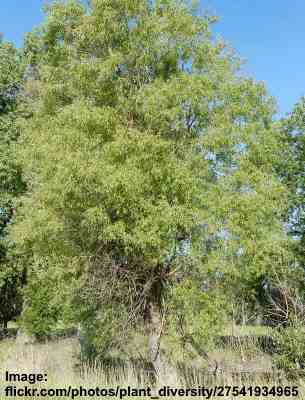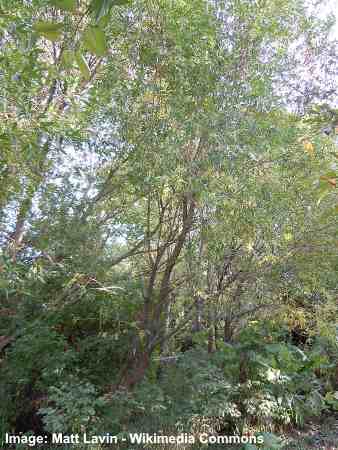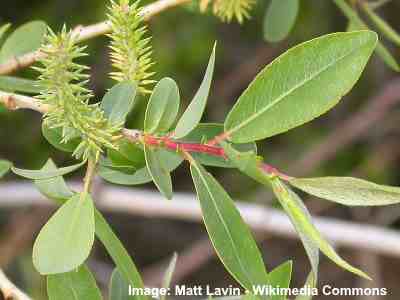Types of Willow Trees: Weeping Willows, Willow Shrubs, Dwarf Willows and More (With Pictures and Name)

Willows include a wide variety of plants from large weeping willow trees to dwarf willows and low-growing creeping shrubs. All types of willows thrive in wet, boggy soil and some willow species also do well in dry soil. Willow trees and shrubs grow well in temperate and cold climates. Because of their graceful shape and elegance, weeping willows are popular landscape garden trees.
Willows are a type of deciduous plant belonging to the family Salicaceae in the genus Salix. Depending on the type of species, other names for willows include:
- Tree willows. Trees or large shrubs with lanceolate leaves.
- Osier willows. The osier, also called basket willows, are tall narrow willow shrubs with narrow leaves.
- Sallows. These willows are small trees or low shrubs with broad oval leaves.
There are over 400 species of willow that grow in many countries in the Northern Hemisphere.
How to Identify Willow Trees and Shrubs
Tree willows can be identified by their lanceolate leaves (lance-shaped leaves) that have light feather veins. The leaf edges are gently serrated. Another way to identify willow trees in deciduous forests, parks, or green spaces is that they are usually the first trees to have leaves in the spring.
Osier willows (basket willows) can be identified by their long narrow leaves. These willows are tall narrow shrubs.
Sallows (shrub willows) can be identified by their broad oval shaped leaves that have toothed edges.
In this article, you will learn about the many types of willow trees. Pictures of willow trees, descriptions of their features, and their scientific names will help identify different species of willows.
Interesting Facts About Weeping Willow Trees
Weeping willow trees are also fast-growing with aggressive roots that search out moisture. It isn’t recommended to plant willows near underground lines such as water, gas, or electricity.
Willow trees can have great height differences: the Dwarf Willow only grows as high as 5 ft. (1.5 m). Whereas the Weeping Willow can grow up to 82 feet (25 m) in height.
The Latin name for the willow group is Salix. This scientific name also gives its name to a chemical compound found in willow plants called salicylic acid. This is the precursor to the pain-relieving drug aspirin.
Another interesting fact about willows is that willow wood is strong yet pliable. Wood from willow trees is used to make furniture, musical instruments, sports bats, and toys. Also, willow rods can be used to make woven wicker baskets.
Weeping Willow Trees

Weeping willows grow well near rivers and lakes and can be easily identified by their long drooping branches
Most people can easily recognize types of weeping willow trees. Their long cascading branches give the tree a moody yet elegant and graceful appearance. Weeping willow trees grow between 66 and 82 ft. (20 – 25 m) tall. Their leafy arching branches are so long that they almost touch the ground.
Weeping willow leaves are also easy to identify. Weeping willow has narrow, light-green leaves with a silvery shine that grow between 1.5” and 6” (4 – 15 cm) long and only around 0.8” (2 cm) wide. The weeping willow narrow-leaf margins are finely serrated. In the fall, weeping willow trees turn a stunning golden yellow color.
Weeping willows are also flowering trees. The fuzzy flower spikes—called catkins—appear in early spring.
Weeping willows grow exceptionally well in landscapes beside streams, rivers, lakes, and ponds, where they help to stabilize the ground.
Most species of weeping willows grow well in zones 4 or 5 through to 9.
Dwarf Weeping Willow Trees
Dwarf weeping willow trees are beautiful ornamental trees for small-scale landscapes. The short-stature attractive willows have pendulous branches creating an umbrella-like canopy. The small, pretty trees are ideal for growing in compact gardens or large containers.
The beauty of growing dwarf willow trees is that they never grow too tall. Typically, dwarf willow varieties mature between 3 and 6 ft. (1 – 2 m) tall with a spread of up to 5 ft. (1.5 m). Like larger weeping willows, the dwarf cultivars have narrow, pointed leaves and produce yellow furry flowers (catkins) in the spring.
Willow Leaves

Willow leaves
Willow leaves—including weeping willows, dwarf varieties, and willow shrubs—are typically long and thin. The pointed green leaves are lanceolate shaped with finely-toothed margins. Identifying willow leaves also helps recognize which type of willow the leaf is from. Only the goat willow (Salix caprea) has rounded, oval leaves with a short, pointed tip.

Goat willow (Salix caprea) leaves
Willow shrubs, such as many osier willows, have very narrow green leaves, some of which have long, tapered ends. The thin willow shrub leaves grow up to 10” (25 cm) long. Some osier willows, such as the common osier (Salix viminalis), have green willow leaves with a silver-gray underside.

Common osier (Salix viminalis) leaves
Sallow willows tend to have oval, broader leaves with serrated margins and a twisted, pointed tip.

Sallow willow (Salix cinerea) leaves
A common identifying feature of most willows is that they are some of the first trees in late winter or early spring to grow leaves. Also, in the fall, when willows turn bright yellow, they are among the last trees to drop their leaves.
Willow Tree Bark

Weeping willow bark (left) and goat willow bark (right)
Willow tree bark tends to be gray, rough and fissured. A notable feature of many willow trees is ridged bark that forms crisscross patterns vertically on the tree. Mature willow tree bark becomes loose and flaky with a shaggy appearance. Additionally, the willow bark appears dark gray to black as it matures.
An attractive feature of the bark on many willow shrubs and small willow trees is their red winter color. Multi-stemmed willow shrubs such as the Flame Willow (Salix alba ‘Flame’) and Scarlet Willow (Salix alba var. vitellina ‘Britzensis’) develop orange-red or bright orange bark.

Salix alba ‘Flame’ bark
Willow Flowers

Willow flowers (catkins)
Willows produce unusual flowers that look like long white or yellow woolly buds growing on red or gray stems. Weeping willows tend to have longer, thin furry flowers (catkins) that are usually a yellow color.
Most varieties of willows and sallows, such as the American pussy willow, gray willow, and other small willow species, produce woolly catkins in early spring. The strange flowers don’t have recognizable petals or any fragrance.
Because willow flowers resemble small, furry cats, they are sometimes named pussy willows.
Willow Tree Identification
To identify willow trees, look at the leaf shape, type of flower, and growth habit. Willows trees tend to have long, linear, pointed lance-shaped leaves. Some species of willow have silvery-white to gray leaves, but most have serrated edges. Willow shrubs and trees are easy to identify in spring by their furry flowers.
Weeping willow trees are some of the easiest trees to identify in a landscape. The tall, imposing trees have arching, pendulous branches covered in long, thin green leaves. Weeping willow twigs and branches can be a light yellow or greenish-yellow color.
Types of Weeping Willow Trees with Pictures for Easy Identification
Weeping Willow (Salix babylonica)

Weeping willow tree can be easily identified by its droopy branches
The weeping willow (Salix babylonica) has thin lanceolate leaves that taper to a narrow point. Its pendulous branches give the tree its classic weeping look. Leaf stems are a yellowish-brown color. This beautiful weeping willow has a fast growth rate and it can grow to between 62 and 82 ft. (20 – 25 m) tall.
The Babylon willow is the most common and easily recognizable type of weeping willow. It usually goes by the common name weeping willow—even though there are many weeping willow varieties. Although its scientific name suggests it’s from the Middle East, the common weeping willow is native to China.
Weeping willows also have an attractive color in winter. After shedding their golden-yellow leaves in the fall, drooping yellow branches make this tree interesting to look at.
The weeping willow tree has gorgeous yellow flowers that look like long fuzzy spikes in the spring season.

Weeping willow inflorescence (flower)
Weeping willow tree leaves

Weeping willow leaves
The Babylon weeping willow has elongated, pointed linear leaves that grow up to 6” (15 cm) long and 1” (2 cm) wide. Leaves turn golden yellow in the fall.

Weeping willow bark
Weeping Golden Willow (Salix × sepulcralis ‘Chrysocoma’)

The golden weeping willow is a hardy type of willow tree
The weeping golden willow tree has beautiful arching cascading branches that droop straight down and in a light olive-green color. This species of weeping willow grows about 72 ft. (22 m) tall. The weeping tree produces yellow fuzzy flowers (catkins) in spring on golden young yellow twigs.

Weeping golden willow flowers
The golden weeping willow gets its name from the lanceolate young yellow-green leaves growing on cascading branches. As the season progresses, these leaves turn a glossy green color.
The weeping golden willow is a hybrid cross between the Salix babylonica and Salix alba. Like most varieties of weeping willows, the golden variety grows well in USDA zones 5 to 9 and thrives in wet, soggy soil.
Weeping willow tree leaves

Weeping golden willow leaves
The golden weeping willow has characteristic long and thin tapered green willow leaves with a glossy shine.

Weeping golden willow bark
White Weeping Willow (Salix alba ‘Tristis’)
The white weeping willow is a deciduous weeping tree with a stout trunk and drooping branches. The willow tree has pale green leaves, and woolly flowers appear in spring and are 2” (5 cm) long. White weeping willows grow 50 to 70 ft. (15 – 21 m) tall in USDA zones 4 to 8.
The white willow is also a type of golden weeping willow tree that is sometimes mistaken for the golden weeping willow ‘Chrysocoma.’ Comparing pictures of both willow species, you will see that the Salix alba ‘Tristis’ has a fatter trunk.
Often seen growing alongside rivers, streams, and ponds, the white weeping willow has thin yellow cascading stems. These droop down so much that they almost reach the ground. Its foliage is narrow lance-shaped leaves that turn from bright green to dark green then to golden yellow.
After the leaves shed in the fall, beautiful yellow twigs are left dangling, forming the classic weeping willow shape. Many botanists regard the beautiful white willow as one of the best types of weeping willows to grow in landscapes.
Weeping willow tree leaves

White weeping willow leaves
The white weeping willow has thin, lanceolate leaves with finely serrated margins. The gray-green weeping willow leaves are 4” (10 cm) long and have a silvery-white underside.
Wisconsin Weeping Willow (Salix x blanda and Salix x pendulina)
The Wisconsin weeping willow is a stunning tree with drooping branches covered with long, narrowly lanceolate leaves. The yellowish-brown branches cascade from the willow trees, giving it a sad weeping appearance. Small fuzzy flowers appear in spring. Wisconsin willow only grows to between 20 and 40 ft. (6 – 12 m) tall.
You can identify this weeping willow due to its shorter height, broad, spreading crown, and loosely pendulous branches.
Because of the aggressive growing nature of the roots, weeping willows are not recommended as landscape trees for backyards. Also, the weak stems mean that the willows are “messy” trees that easily shed their branches.
Weeping willow tree leaves
Wisconsin weeping willow leaves are long and tapering with serrated margins. The weeping willow leaves grow up to 6” (15 cm) long. The thin lanceolate green leaves contrast with the yellowish-brown branches.
Dwarf Weeping Willow Trees (With Pictures)
If you have a little space in your garden and you love the droopy look of weeping willows, then you can choose dwarf weeping willows.
Dwarf Weeping Willow (Salix integra ‘Pendula Waterfall’)
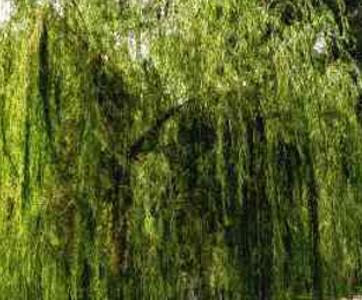
The dwarf weeping willow is an excellent miniature weeping tree for a yard with little space
The ‘Pendula Waterfall’ weeping willow has narrow green linear leaves with rounded tips. The attractive long leaves contrast with reddish-brown branches that dangle down in a weeping growth habit. This miniature weeping willow grows up to 5 ft. (1.5 m) tall in 20 years.
This Salix integra ‘Pendula Waterfall’ is a perfect weeping tree for patios, balconies, and tiny gardens. The attractive dwarf willow also grows well in containers. The dwarf weeping willow thrives in partial sun in USDA zones 5 to 7.
This dwarf tree is also known as the Waterfall Willow due to its mound-forming, weeping growth habit.
Dwarf weeping willow tree leaves
The ‘Pendula Waterfall’ dwarf weeping willow has oblong green leaves that are slightly twisted, growing alternately on drooping branches.
Dwarf Weeping Willow ‘Kilmarnock’ (Salix caprea ‘Kilmarnock’)
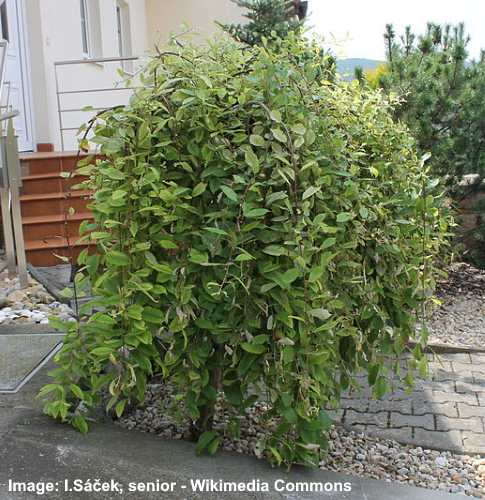
Dwarf Weeping Willow ‘Kilmarnock’ (Salix caprea ‘Kilmarnock’)
The small weeping willow ‘Kilmarnock’ is a low-growing deciduous willow tree with arching branches that cascade to the ground. This pretty dwarf weeping tree has dark-green leaves with silvery-gray undersides. In spring, beautiful gray fuzzy flowers turn yellow on red, bare branches.
The ‘Kilmarnock’ dwarf weeping willow grows between 4 and 8 ft. (1.2 – 2.4 m) tall and 5 ft. (1.5 m) wide. It has an attractive distinct umbrella shape.
As one of the more beautiful dwarf weeping willows, the ‘Kilmarnock’ willow is perfect for small, compact gardens. You can also grow this weeping species as a patio tree in a large container.

Dwarf Salix caprea ‘Kilmarnock’ leaves and flowers
To care for the dwarf weeping willow ‘Kilmarnock’ grow it in full sun or partially shady locations. To promote new growth, lightly prune the dwarf willow tree in the winter every three to five years. It is recommended to water it once a week or more frequently in very hot climates.
Dwarf weeping willow tree leaves
The miniature weeping willow ‘Kilmarnock’ leaves are ovate to lanceolate with finely serrated margins.
Related reading: Beautiful small and dwarf weeping trees.
Types of Willow Trees with Pictures for Easy Identification
Not all types of willow have a weeping growth habit. Let’s look in detail at species of willow that are types of trees or shrubs with branches that don’t droop or cascade.
Pussy Willow / Goat Willow (Salix caprea and Salix discolor)
Goat willows have broader leaves than most willows and are also classified as a type of sallow. Like most plants in the willow family, pussy and goat willows grow in damp environments. They can grow to between 26 and 33 ft. (8 – 10 m) high.
The furry catkins are the reason smaller species of willows are referred to as pussy willows. These fuzzy “buds” start as a gray-white color and turn yellow as the little flowers blossom. They get the name due to their likeness to tiny cats. These catkins appear in early spring and usually precede the leaves.

Goat willow buds (left) and flowers (right)
The most common species of pussy willow is the Salix caprea in Europe and the Salix discolor in North America. These related species are better known by their common names, pussy willow or goat willow.
Willow tree leaves

Pussy willow leaves
Pussy willow tree leaves are broadly elliptic with an oval shape and twisted tip. The gray-green, glossy willow leaves have serrated margins and measure up to 4” (10 cm) long.
Scouler’s willow (Salix scouleriana)
Scouler’s willow is a species of willow classed as a large shrub or small tree that grows in cold, dry environments. Scouler’s willow has multiple straight stems that usually grow to 6.5 and 22 ft. (2 – 7 m). In some conditions, the stems can grow much taller.
The stems of Scouler’s willow are dark brown with lanceolate leaves that have a pointed base. These green leaves can grow to between 2” to 4.7” (5 – 12.5 cm) long and they are identified by their wavy-toothed edges.
Due to the pussy willow-like catkins, other names for Scouler’s willow include western pussy willow, fire willow, and black willow.
Willow tree leaves

Scouler’s willow (Salix scouleriana) leaves
Scouler’s willow tree leaves are spoon-shaped green leaves with a broad, rounded end that tapers at the stem. The dark-green willow leaves measure between 2” and 5” (5 and 12 cm) long. A feature of these willow leaves is the smooth green upper side and fuzzy, whitish-green underside.
Hooker’s Willow (Salix hookeriana)
Hooker’s willow is a type of willow shrub or small tree growing up to 26 ft. (8 m) tall and 10 ft. (3 m) wide. This species of bushy willow has oval leaves, dense foliage, and fuzzy spring flowers. This pussy willow variety thrives in USDA zones 6 to 10 and can withstand growing in coastal regions.
Because it grows near coasts, it is also called the dune willow or coastal willow. You can often find Hooker’s willow growing on the west coast of North America and in floodplains, marshes, and canyons.
Willow leaves

Hooker’s willow leaves and flowers
Hooker’s willow leaves are ovate-shaped with a glossy green upper side. You’ll notice that the willow leaves grow up to 4” (11 cm) and have finely-toothed margins with wavy edges.
Peachleaf Willow (Salix amygdaloides)
The peachleaf willow tree can grow between 13 and 66 ft. (4 – 20 m) tall, and it thrives in the grasslands of North America. The tall willow tree has bushy, green foliage consisting of long, lanceolate, olive-green leaves. In spring, yellow woolly willow flowers (catkins) appear on bare branches.
As the common name of this willow suggests, the small to medium-sized peachleaf willow tree’s leaves look like peach tree leaves. Depending on the species, the peachleaf willow tree can have just one trunk or be a multi-stemmed tree.
The peachleaf willow is a fast-growing type of willow tree; however, it doesn’t last a long time.
Willow tree leaves

Peachleaf willow leaves
The peachleaf willow has long lance-shaped green leaves that have characteristic serration on the edges. The underside of the leaves is a pale, whitish color. The peachleaf willows have a beautiful golden yellow fall color.
Pacific Willow (Salix lucida)
The Pacific willow tree is a large shrub or small willow tree growing between 13 and 36 ft. (4 – 11 m) tall. Also called black willow or whiplash willow, the graceful willow has dark bark and long glossy lanceolate green leaves. Yellow furry flowers measuring 0.4” – 3. 5” (1 – 9 cm) long appear in spring after the leaves.
The common names of the Pacific willow come from the leaf growth. The tips of the leaves curve, which is why it gets the name whiplash willow. This pacific willow species is one of the few varieties with flowers appearing after the leaves emerge.
Willow tree leaves

Pacific willow leaves and flowers
The Pacific willow tree leaves are lanceolate-shaped leaves with a dark-green glossy shine. The deciduous leaves are described as acuminate—meaning they taper to a point.
Corkscrew Willow (Salix matsudana ‘Tortuosa’)
Also known as curly willow, corkscrew willow (Salix matsudana ‘Tortuosa’) is a type of weeping willow with long leaves, twisted branches, and gray-brown bark. It has fuzzy pale yellow-green flowers (catkins) that appear in early spring.
Corkscrew willow is a classic Chinese weeping willow that is popular in many countries. This willow cultivar, the ‘Tortuosa’ is called the corkscrew willow due to its spiral twisting branches that have an upright form unlike other weeping willows.
The corkscrew willow is a large tree and isn’t classed as a deciduous shrub. It can grow to between 20 and 40 ft. (6 – 12 m) tall and is identified by its large number of crooked stems.
Because of the twisting nature of the corkscrew willow tree, it is also a popular dwarf variety of willow and is popular among bonsai enthusiasts.
Willow tree leaves
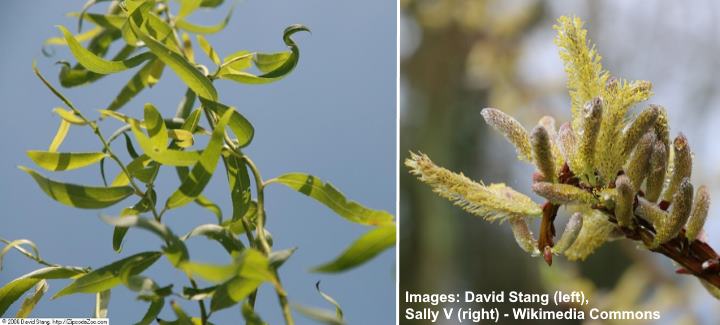
Corckscrew willow leaves and flowers
The corkscrew willow has some of the most unusual willow tree leaves. The corkscrew willow has long strap-like pointed leaves that grow curled and twisted like the growth of this crooked willow tree. The corkscrew willow leaves grow up to 4” (10 cm) long.
Dappled Willow (Salix integra ‘Hakuro-Nishiki’)
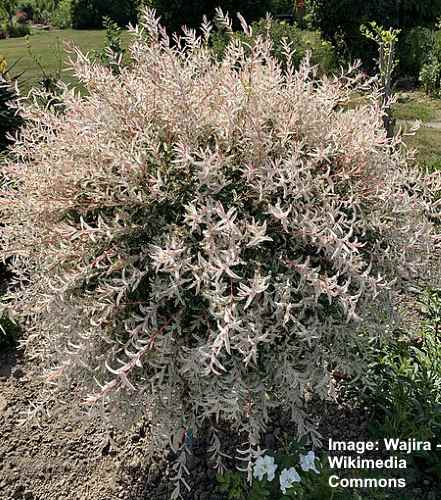
The dappled willow is a type of variegated small willow tree
Also known as Japanese willow or flamingo willow, the dappled willow (Salix integra ‘Hakuro-Nishiki’) is a small shrub or shrubby tree that grows to between 4 – 6 ft. (1.2 – 1.8 m) tall. The colorful willow leaves are 0.8” to 4” (2 – 10 cm) long and only up to 0.8” (2 cm) wide.
One of the fascinating features of the dappled Japanese willow is its variegated long, thin leaves that are green with blotches of white and pink colors. Unlike most other species of willow, the leaves are arranged on stems in opposite pairs rather than alternately.
After the leaves shed in the fall, the branches of the flamingo willow turn a nice red color in winter.
Some other names for this variegated species of willow include tricolor willow, Nishiki willow, or Japanese variegated willow.
The Japanese willow is one of the most spectacular dwarf willows with upright growth you can grow in your sunny garden.
Willow tree leaves

Dappled willow leaves
The beautiful ‘Hakuro-Nishiki’ willow leaves are variegated pencil-thin, lance-shaped leaves. The creamy-white and green leaves turn stunning shades of yellow in the fall.
Purple Willow (Salix purpurea)

Purple willow (purple osier willow) has young purple shoots and purple-red flower clusters
The purple willow grows around 10 ft. (3 m) tall. The leaves are typical of willow plants—lanceolate in shape and having an elongated look. There are a few unique features of the purple willow. The catkins (flowers) are smaller than most willow plants and are purple or red rather than white or yellow.
This small willow shrub is also known as the purple osier willow. This species of willow gets its name from the purple shoots when they are young. As the shrubby willow tree matures, the stems turn pale gray.
There is also a purple osier willow cultivar Salix purpurea ‘Pendula,’ which has arching cascading branches.
Willow leaves
Like most osier willows, the shrub has narrow, lanceolate leaves with finely serrated margins. The leaves have an elegant arching form as they grow on reddish-brown stems.
White Willow (Salix alba)
The white willow is a medium-sized tree, growing between 32 to 98 ft. (10 – 30 m). Its gray-brown fissured trunk measures up to 3.2 ft. (1 m) in diameter. The majestic willow has thin pointed leaves with whitish-gray undersides. Its fluffy flowers measure 2” (5 cm) long. The hardy willow grows in USDA zones 4 to 8.
The common white willow is a large willow tree that is native to Europe and Central Asia. Its common and scientific names come from the white undersides of the thin narrow leaves. This Salix alba differs from the Salix alba ‘Tristis’ cultivar because the common white willow doesn’t weep or have drooping branches.
Other Salix alba cultivars include ‘Caerulea,’ which is grown for its lightweight, extremely strong wood, and the ‘Vitellina’ golden willow which has attractive yellow shoots.
Willow tree leaves

White willow leaves and flowers
The white willow has distinguishing pale green leaves that are paler than other willows. The lanceolate pointed leaves are covered in fine white hairs.
Scarlet Willow (Salix alba var. vitellina ‘Britzensis’)
The scarlet willow is regarded as one of the most beautiful types of willow trees with colored bright red or orange bark. The fast-growing tree can grow between 15 and 70 ft. (4 -21 m) tall and 10 to 40 ft. (3 – 12 m) across. The narrow lance-shaped leaves are finely serrated and turn from dark green to yellow in the fall.
The scarlet willow is a white willow cultivar that has attractive red stems in the winter. This medium-sized deciduous willow tree can also grow as a stunning multi-stemmed type of landscape shrub.
This spectacular willow shrub or tree is perfect for adding winter color to your garden
Willow tree leaves
The colorful willow leaves are narrow, pointed, and lanceolate. The thin willow leaves gradually taper at the tip and base. Scarlet willow leaves are 4” (10 cm) long.
Yellow Willow (Salix lutea)
The yellow willow is a sizeable shrubby tree that grows up to 22 ft. (7 m) tall. The green leaves grow on reddish stems in an alternate pattern. The dull green lance-shaped leaves have a more oval shape than other willows and can reach 4.3″ (11 cm) long. The yellow willow has 2-inch (5-cm) long greenish spiky flowers (catkins) when it flowers in spring.
Yellow willows are found in many wet habitats in North America. You’ll find the shrubby willow growing along rivers and streams and on the banks of lakes.
This willow grows quickly, easily reproduces, and has an intricate root system, making it a popular tree to plant where soil erosion is a problem.
Willow leaves
Yellow willow leaves are light green and are pointed when immature, then gradually develop rounded tips.
Types of Willow Shrubs with Pictures for Easy Identification
Bebb’s Willow (Salix bebbiana)
Bebb’s willow is a tall deciduous, fast-growing shrub featuring multiple woody stems with thick foliage. The leaves on this shrubby willow measure around 5” (12 cm) and are the characteristic willow ovate to lanceolate shape with a pointed tip. The stems of Bebb’s willow can grow to between 10 and 30 ft. (3 – 9 m).

Bebb’s willow catkins have distinct look with round base and a long beak
This willow species is also classified in a group of diamond willows. These get their name from distinct diamond markings that appear on the twigs. Bebb’s willow goes by other names such as gray willow, long-beaked willow, beaked willow, and red willow.
Bebb’s willow shrubs are also hardy willow plants that thrive in USDA zones 3 to 7. Like most willow species, Bebb’s willow grows best in full to partial sun and wet, sometimes flooded ground.
Willow leaves

Bebb’s willow leaves
Bebb’s willow leaves are broadleaves that are ovate shaped with a tapered tip and base. The willow leaves have serrated, wavy edges.
Narrowleaf Willow (Salix exigua)
The narrow-leaf willow is a deciduous shrub that grows throughout much of North America. As its name implies, the narrowleaf willow shrub has long, narrow leaves. Other names for this species include coyote willow or sandbar willow.
What are the identifying features of the narrowleaf willow? The long woody stems can grow between 13 and 23 ft. (4 – 7 m). This densely growing shrub has leaves that are up to 4.7” (12 cm) long and between 0.079 and 0.39” (2 – 10 mm) wide. Long furry catkins measuring 4” (10 cm) long appear in spring.
The firm, flexible stems of narrowleaf willows can be used to make baskets, poles, and even string.
Willow leaves

Narrowleaf willow leaves and flower
The narrowleaf willow shrub has pencil-thin, pointed green leaves. Like many willow species, the leaves have silky white hairs on their underside.
Related articles:






